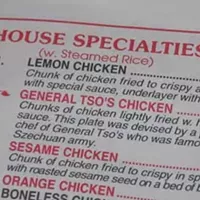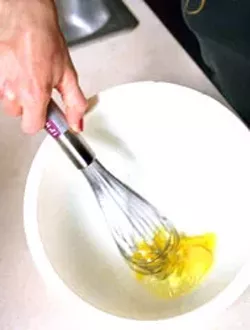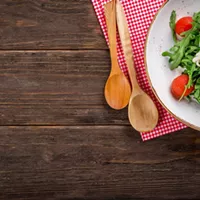In most cases these simple homemade foods are far superior to their supermarket cousins. Bread is a good example of this, tomato sauce is another, and so is homemade mayonnaise. Mayonnaise is so commonplace in today's world that it's used without thinking about what it actually is. You may already know it's high in fat, and it contains a high proportion of oil and egg. Mayonnaise is a luxury, there's no question, and it's also food science in a bowl. It's an amazing thing, actually, to make mayonnaise from scratch -- it's nothing short of alchemy.
Mayonnaise is an emulsion. The definition of an emulsion is the combining of two or more ingredients that do not normally combine. In the case of mayonnaise the lemon (or vinegar) and oil are emulsified into a homogeneous mass. There are two types of emulsions: temporary and permanent. An example of a temporary emulsion is vinaigrette sauce; mayonnaise is a permanent emulsion. To create a permanent emulsion, an emulsifying agent has to be used. The emulsifier in mayonnaise is lecithin, which is a naturally occurring protein found in eggs, specifically in their yolks.
The concept of an emulsion is simple -- whisk and beat together two ingredients that normally do not combine until they break apart into small enough droplets that they seemingly blend together and are indistinguishable from one another. Ultimately the two ingredients become one. The tricky part is keeping them that way. This is where an emulsifier comes in.
Classically, when mayonnaise is made egg yolks are vigorously beaten with a little acidic liquid (lemon juice or vinegar), salt, and mustard. Beating the yolks aerates them, meaning that it incorporates air into them and will ultimately make a more light and fluffy sauce. Once the eggs are sufficiently aerated, oil is slowly incorporated into the yolks. This is initially done in a very thin stream but once it "catches," the oil may be added at a much faster rate. As the oil is whisked and beaten into the yolks an amazing thing happens: the ingredients in the bowl change color and become a thick mass. What is happening is as the oil is being broken into smaller and smaller droplets -- through whisking -- and the lecithin is wrapping itself around each droplet, which keeps them separate, and sort of piles them up rather than allowing them to run together. This is the reason that a properly made mayonnaise doesn't run, and is thick enough to be spread.
This all may sound too technical, but it's just meant to illustrate what mayonnaise is. And while making mayonnaise is a simple process, as with any recipe there are a few guidelines to follow. The two most important considerations have been previously mentioned -- aerate the yolks sufficiently, and add the oil in a slow but steady stream. Another thought is to keep the liquid, yolks, and oil in proper proportion. One yolk has enough emulsifying power to thicken one cup of oil, any more and you risk breaking (separating) the emulsion; there simply would not be enough lecithin to coat all of the oil droplets. And slightly more than 1 tablespoon of lemon or vinegar is enough acidic liquid to offer 1 cup of oil proper flavor and consistency; any more and the mayonnaise may be runny.
As with many foods, there's more than one theory on the origin of this unique sauce. The most commonly regarded speculation, though, is that it takes its name from the town of Mahon on the island of Minorca, just off the coast of Spain. It's said that in 1756 the French captured the town from the English, and the French government had a banquet to honor their victorious General. The chef was short on supplies, including butter and cream, which he was so accustomed to using, and being as dedicated and inspired as any chef of his day, he used what was plentiful on the island -- olive oil and eggs. Supposedly he made a sauce to accompany some rather dry meat, and dubbed it Sauce a la Mahonnaise, which eventually came to be known simply as Mayonnaise.
Because mayonnaise is made with raw egg yolks, there are some safety concerns to be aware of. In response to the potential bacterial risk in raw eggs, the USFDA recommends that any foods that are to be consumed with eggs be heated to above 160 degrees Fahrenheit, temperatures that would cook egg yolks and ruin mayonnaise. While the risk of salmonella in raw eggs is real, it's also slight. It's estimated that less than one egg in 10,000 may be tainted. One of the best precautions is to purchase the freshest eggs possible, and make sure that all implements used are clean. The important thing is to remember that the eggs in mayonnaise are raw, and basic safety concerns should be observed, such as keeping mayonnaise refrigerated. It's best to consume homemade mayonnaise within three days of preparing it.
Lastly, for those who are less than enthusiastic about mayonnaise, they can actually join the "I Hate Mayonnaise Club" (I'm not sure why I am even giving them the publicity; I guess I just find it so bizarre). The club even has its own website at www.nomayo.com. For a nominal fee, a member "in good standing" will receive their official card, an 8 by 10 certificate, bumper sticker, and window sticker. According to the website, the author is also in a "fierce" legal battle over the rights to the name of the club and the Internet domain.
And I thought I spent too much time delving into and obsessing over esoteric subjects.
Speaking of Cuisine_feature.html, 5.00000
-
A Family Affair
Dec 12, 2007 -

Darrell Roach
Dec 12, 2007 -
Body Talk
Dec 12, 2007 - More »
Latest in Food & Drink Features
More by Joe George
-

Tso what?
Oct 7, 2008 -
Apple Nirvana
Dec 18, 2002 -

Corn, The Wonder Plant
Oct 2, 2002 - More »
Calendar
-

Armored Car Brewing Food Truck Friday @ Armored Cow Brewing
-

Trap & Paint (Hookah Edition) @ Blush CLT
-

Queen City Tequila Festival @ Blush CLT
-

Queen City Mimosa Festival & Day Party @ Blush CLT
-

The Dinner Detective True Crime Murder Mystery Dinner Show - Charlotte, NC @ DoubleTree by Hilton South Charlotte Tyvola.
-
Dorie Greenspan's Tiramisu Cake
This layered cake is definitely a "pick-me-up" with a little booze and caffeine.
-
What local chefs are reading for fresh ideas in food
Cookbooks can be page turners
-
For The Splurge Of It
Wines so good you may even forget the price - for a minute









